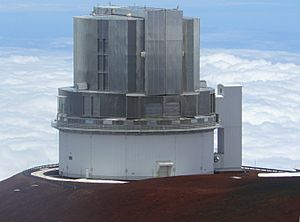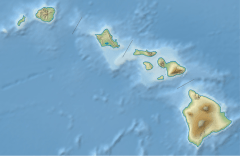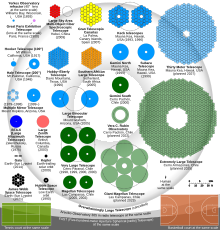Subaru Telescope facts for kids

The Subaru Telescope
|
|
| Part of | Mauna Kea Observatories National Astronomical Observatory of Japan |
|---|---|
| Location(s) | Mauna Kea, Mauna Kea, Hawaii, US |
| Coordinates | 19°49′32″N 155°28′34″W / 19.8256°N 155.4761°W |
| Organization | National Astronomical Observatory of Japan |
| Observatory code | T09 |
| Altitude | 4,139 m (13,579 ft) |
| Wavelength | Optical/Infrared |
| Built | Completed 1998 |
| Telescope style | optical telescope reflecting telescope Ritchey–Chrétien telescope |
| Diameter | 8.3 m (8.2 m usable) |
| Secondary diameter | 1330/1400/1265 mm |
| Angular resolution | 0.23″ |
| Collecting area | 53 m2 (570 sq ft) |
| Focal length | f/1.83 (15.000 m) |
| Mounting | Altitude/Azimuth |
| Enclosure | cylindrical dome |
| Website | www |
The Subaru Telescope (which means "Pleiades" in Japanese) is a very powerful telescope. It belongs to the National Astronomical Observatory of Japan. This amazing telescope is located on Mauna Kea, a tall mountain in Hawaii. It has a huge main mirror, about 8.2 meters (27 feet) wide. For a while, it had the largest single mirror in the world!
Contents
What is the Subaru Telescope?
The Subaru Telescope is a special kind of reflecting telescope called a Ritchey-Chretien telescope. It uses mirrors to gather light from space. This design helps it get very clear images.
How does the Subaru Telescope work?
The telescope has different places where cameras and other tools can be attached.
- One place is called the Cassegrain focus, which is below the main mirror.
- There are also two Nasmyth focal points on the sides. Light can be sent there using a third mirror.
- Another option is the prime focus. This is unusual for large telescopes. It gives a very wide field of view, which is great for surveying large areas of the sky.
When was the Subaru Telescope built?
The idea for a large Japanese telescope started in 1984. The University of Tokyo began planning for a 7.5-meter telescope. In 1986, they agreed with the University of Hawaii to build it in Hawaii.
The National Astronomical Observatory of Japan was created in 1988. This group would manage the new telescope project. Construction of the Subaru Telescope began in April 1991. It was finished in 1998. The first scientific pictures were taken in January 1999. Japan's Princess Sayako officially opened the telescope in September 1999.
What makes Subaru Telescope special?
The Subaru Telescope uses many advanced technologies.
- Its main mirror is supported by 261 computer-controlled devices. These devices gently push the mirror from underneath. This helps keep the mirror in perfect shape, even as the telescope moves.
- The building around the telescope is also designed to help. It reduces air movement that can blur images. This helps astronomers get clearer views of space.
For its opening, a special eyepiece was made. This allowed Princess Sayako to look through the telescope directly. It was a rare chance to see through such a powerful telescope with the naked eye!
What does the Subaru Telescope study?
The Subaru Telescope is a key tool for astronomers. It helps them search for new planets and study distant galaxies.
Searching for Planet Nine
The Subaru Telescope is very important in the search for Planet Nine. This is a possible planet far out in our solar system. Subaru's wide field of view is 75 times bigger than some other telescopes. This means it can see a much larger area of the sky at once. It also gathers a lot of light, which helps it see faint objects. These features make it perfect for big sky surveys. Scientists expect this search to take several years.
Instruments used at Subaru Telescope
The Subaru Telescope can use many different cameras and tools. These instruments help scientists observe objects in both visible light and infrared light. This allows them to study different kinds of information from space.
Images for kids
-
The Subaru Telescope next to the W. M. Keck Observatory telescopes and the Infrared Telescope Facility.
-
A map of dark matter from 2018, created using data from the Hyper Suprime-Cam survey.
See also
- List of largest optical reflecting telescopes
- Yūko Kakazu
 In Spanish: Telescopio Subaru para niños
In Spanish: Telescopio Subaru para niños





